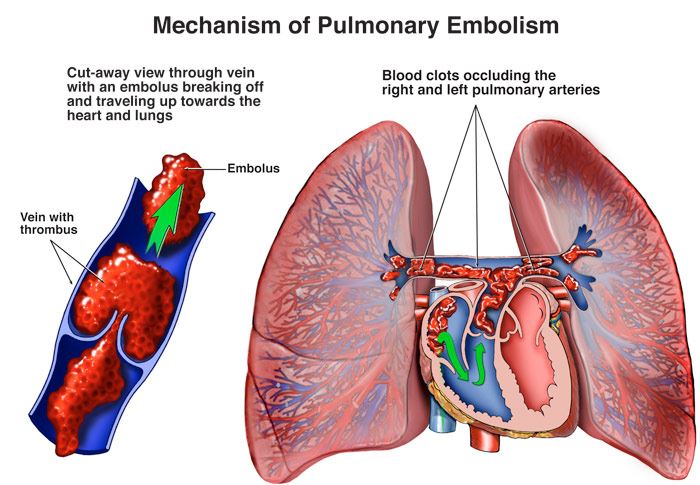Pulmonary Embolism
A pulmonary embolism is a medical emergency and can be fatal if not diagnosed and treated quickly. Anyone who experiences an acute onset of chest pain, lightheadedness, rapid breathing, spitting up blood, weak pulse, should call 911 immediately.
A Pulmonary Embolism (PE) usually happens when a blood clot in the leg, called a deep vein thrombosis, breaks loose and travels through the blood stream to the lung. PE is a serious condition that can cause permanent damage to the lungs, low oxygen levels in your blood, and damage to other organs in your body from not getting enough oxygen.

Medical Illustration Copyright © 2019 Nucleus Medical Media, All rights reserved.
Causes of Pulmonary Embolism
The cause is usually due to deep vein thrombosis. However, other conditions, traits or habits may also play a role in raising your risk. These conditions are known as risk factors and include:
Non-Modifiable Risk Factors: These factors are irreversible and cannot be changed. The more of these risk factors you have, the greater your chance of developing PE.
- Age over 60 years
- Family history of embolisms
- Family history of heart attack or stroke
- Genetics
Other conditions that contribute to the development of PE:
- Injuries like bone fractures or muscle tears can cause damage to blood vessels, leading to clots.
- Chemotherapy
- Cancers of the brain, ovary, pancreas, colon, stomach, lung and kidney.
Symptoms of Pulmonary Embolism
The symptoms of PE vary greatly. They're often related to the size and where it lodges in the lung. Some common symptoms include:
- Anxiety
- Chest pain
- Heart palpitations
- Heart arrhythmias
- Lightheadedness
- Rapid breathing
- Spitting up blood
- Weak pulse
Diagnosis of Pulmonary Embolism
To diagnose your condition, your doctor will ask you about your symptoms. You'll also have a physical exam. After that, your doctor may recommend diagnostic tests. Some of the diagnostic tests and procedures include:
- Blood tests
- Chest x-ray
- Angiogram
- Ultrasound
- Computed tomography (CT scan)
- Magnetic resonance imaging (MRI)
Treatment of Pulmonary Embolism
Your treatment for a pulmonary embolism depends on the size and location of the blood clot. If the problem is minor and caught early, your doctor may recommend medication as treatment. Some drugs can break up small clots. If further treatment is required, these are some treatment options:
Medications
- Anticoagulants “blood-thinners” will help treat, prevent, and reduce blood clots.
- Thrombolytic therapy is the administration of drugs called “lytics” or “clot busters” that will help break up or dissolve blood clots.
